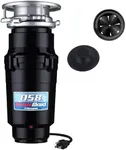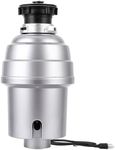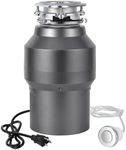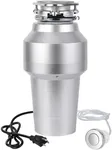Buying Guide for the Best Garbage Disposals For Under Sink
Choosing the right garbage disposal for your under-sink setup can make kitchen clean-up much easier and more efficient. When selecting a garbage disposal, it's important to consider several key specifications to ensure you get a model that fits your needs and kitchen setup. Here are the main factors to consider and how to navigate them to find the best fit for you.Motor PowerMotor power is measured in horsepower (HP) and determines how effectively the disposal can grind up food waste. This spec is important because a more powerful motor can handle tougher food scraps and larger quantities. Motor power typically ranges from 1/3 HP to 1 HP or more. For light use, such as in a small household, 1/3 to 1/2 HP may be sufficient. For average use, 1/2 to 3/4 HP is a good choice. For heavy use or larger households, 3/4 to 1 HP or higher is recommended. Consider your household size and the types of food waste you generate to choose the right motor power.
Grinding StagesGrinding stages refer to the number of times food waste is ground before being flushed away. This spec is important because more grinding stages result in finer waste particles, reducing the risk of clogs. Disposals typically have one, two, or three grinding stages. Single-stage grinders are suitable for light use and softer food waste. Two-stage grinders are better for average use and can handle tougher scraps. Three-stage grinders are ideal for heavy use and can grind almost any type of food waste into very fine particles. Choose based on the types of food waste you commonly dispose of and your clogging concerns.
Noise LevelNoise level is an important consideration, especially if your kitchen is near living areas. This spec is important because a quieter disposal can make your kitchen environment more pleasant. Noise levels can vary significantly between models. Basic models may be louder, while more advanced models often include sound insulation and anti-vibration features to reduce noise. If noise is a concern, look for disposals with noise-reducing technology. Consider your tolerance for noise and the layout of your home when choosing a disposal.
Size and CompatibilitySize and compatibility refer to the physical dimensions of the disposal and how well it fits under your sink. This spec is important because you need to ensure the disposal will fit in the available space and connect properly to your plumbing. Measure the space under your sink and check the dimensions of the disposal unit. Also, consider the type of sink and plumbing connections you have. Some disposals are designed for specific types of sinks or plumbing setups. Choose a model that fits your space and is compatible with your existing plumbing.
Durability and MaterialsDurability and materials refer to the construction quality and the materials used in the disposal. This spec is important because a more durable disposal will last longer and perform better over time. Look for disposals made with stainless steel components, as they are more resistant to corrosion and wear. Higher-end models often use more durable materials and have longer warranties. Consider how often you use the disposal and the types of food waste you process to determine the level of durability you need.
Ease of InstallationEase of installation refers to how simple it is to install the disposal yourself or with minimal professional help. This spec is important because a simpler installation can save you time and money. Some disposals come with easy-mount systems and clear instructions, making them more user-friendly for DIY installation. If you're not comfortable with plumbing work, you might prefer a model that is known for its straightforward installation process. Consider your comfort level with DIY projects and whether you plan to install the disposal yourself or hire a professional.




















